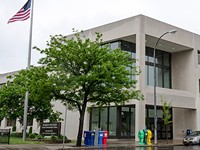[
{
"name": "500x250 Ad",
"insertPoint": "5",
"component": "15667920",
"parentWrapperClass": "",
"requiredCountToDisplay": "1"
}
]
One of the big national news stories last week had a deep local angle, and big implications for Rochester:
The Democrat and Chronicle's parent, the Gannett Company – founded here, and in the long-ago past, headquartered here – plans to split into two parts. One will contain its newspapers and their websites, the other its broadcast division.
In splitting off its publishing division, Gannett is following the lead of some other big public media companies: Tribune, News Corp, EW Scripps, and Journal Communications. The reason for those separations is that the non-newspaper products are more attractive to investors, because they're more profitable. Investors don't buy stock in public newspaper companies to support good journalism; they buy it hoping it'll make money for them. And right now, newspapers are considered a drag on the stocks of companies like Gannett.
"The persistent financial demands of Wall Street have trumped the informational needs of Main Street," concluded New York Times media curmudgeon David Carr.
Our homegrown Gannett is now a media giant. It owns 82 daily newspapers, including the nationally distributed USA Today, and 443 non-daily publications. It owns or has agreements with 46 television stations. It owns the online job-search business CareerBuilder, and it will soon own all of Cars.com.
Gannett's newspapers have still been providing more revenue than broadcast has, but that's simply because there are so many of them. Year-over-year revenue from newspapers hasn't grown since 2006, says media analyst Ken Doctor, who has been commenting on the Gannett split on his online publication Newsonomics. Broadcast has been providing more than half of the company's profits.
And as Gannett has been buying more television stations, says Doctor, it's "rapidly becoming a TV company."
The split raises some big questions about Gannett's future, short-term and long-term. Some analysts speculate that Gannett will almost certainly buy more TV stations. Significantly, the new broadcast company will be able to buy television stations in markets where Gannett already owns newspapers, something federal regulations don't permit a single corporation to do.
Another speculation: that Gannett might buy more newspapers. In the split, the broadcast arm is taking all of the corporation's debt, freeing up resources that the publishing company could use to buy more newspapers. That would represent growth for the company, but it would mean fewer owners of the nation's news media: not a good thing.
It may be just as likely, though, that the result will be fewer Gannett newspapers – perhaps fewer newspapers period – if the publishing company can't hack it on its own. A troubling sign: CareerBuilder and Cars.com, which analysts say are lucrative, are being put in the broadcast company, not the publishing company. So their revenue won't help offset the decline in the newspapers' ad revenue, if it continues.
"I'm very skeptical that in the long term you are going to have a hard copy daily newspaper in each market," media analyst Craig Huber told the New York Times.
It's not likely that the Gannett newspapers will ever show the kind of stunning profits that they did pre-internet. And my hunch is that unless the newspapers start to look like a strong, growing business, Gannett publishing stock won't be attractive to investors.
The Gannett newspapers will feel pressure to demonstrate growth. In the past, they've responded to that pressure with staff cuts. And I can't imagine that there's much left to cut without seriously affecting quality.
On the same day that the corporate split was announced, five Gannett dailies were making announcements of their own – related, you have to assume, to the corporate news.
Editors at the Asheville, North Carolina, Citizen-Times; Pensacola, Florida, News Journal; Greenville, South Carolina, News; Nashville Tennessean; and Asbury Park, New Jersey, Press, told readers that their publications were dramatically reorganizing their newsrooms. As Asbury Park's Hollis Towns put it: "We are building a 21st century newsroom to meet your needs."
Among the changes: they're putting more resources into their digital work, hiring more reporters, "flattening" their management and laying off some managers. They're putting more emphasis on sending reporters out into the community, "listening, tweeting, and holding conversations with you in local coffee shops and delis," Towns wrote.
The five editors used such descriptions as "fundamental and transformative change," "bolder approach," "bolder step," "sweeping overhaul," "sweeping reconfiguration."
Each of the editors stressed their commitment to hard-news coverage, to investigative work, to leading their communities in addressing key challenges such as education and drug abuse: all encouraging words.
"Reporters will be empowered to roam for news and listen to you in a more self-directed way," said Towns' statement. But then he said this: "The stories they write will be based on what you read and click on."
To many journalists, that kind of talk is blasphemous. And that attitude in an editor is not a good sign.
The "bold," "sweeping" changes are taking place only at five Gannett dailies. It's a pilot project, designed, presumably, to see whether it increases readership and revenue. So maybe it won't spread to Rochester.
But the last big change – inserting USA Today into every Gannett daily – began as a pilot, with Rochester one of the testing grounds, and it then rolled out through the chain fairly quickly.
After the Gannett news broke, I e-mailed longtime Democrat & Chronicle reporter Steve Orr, who is president of the Newspaper Guild of Rochester, asking for the Guild's thoughts about the developments.
On the broadcast-publishing split, Orr said this: "While there had been talk that Gannett, like other media companies, might split its television and newspaper divisions, there was no advance warning of the announcement, so it's fair to say many of us were caught by surprise. Since the announcement we've gotten almost no information about the pending change, which apparently won't be consummated for a year or so. So in terms of what it means for the future of the news operation in Rochester or for our jobs, we have no insight yet."
The news about the pilot project in the five Gannett dailies "has created a bit of a stir here today," Orr said, "but we are told these properties are test sites that are trying out various approaches to newsroom organization and news coverage. We are not a test site at present, so we've been told nothing is likely to change here in the near future. But some sort of change may well occur down the road. What, we don't know."
"It appears we're now in a new period of uncertainty," Orr said, "though not the first one by any means. Newsroom employees no doubt share the hope of our readers and viewers that we'll pass through this period more or less intact and be able to continue doing our best to inform the community."
This could end well. Despite my skepticism about the bulking up that the Democrat and Chronicle hyped a few months ago, the news side has been doing some good stuff. There are more reporters, more digging, more watchdogging.
So maybe the spun-off publishing branch will devote itself companywide to investing in quality journalism, in giving us what we need to know in order to function as well-informed citizens. Still, the pilot project going on in the five Gannett dailies makes me nervous.
If sending reporters out to coffee shops to chat with the public spurs readership, and if basing articles on the number of online clicks results in higher profits, maybe the Gannett publishing division will be successful financially. It may not provide the journalism the public needs, though.
And if the new effort doesn't work, and circulation and ad revenue continue to decline, what then?
In a Newsonomics post late last month, Ken Doctor wondered "how much stomach" Gannett still has for the newspaper business. Despite its potential faults, the pilot project indicates that for the moment, the company's publishing executives still want to find a way to keep going.
It's possible that as media companies spin off their newspapers into a separate business, some of those papers will be sold. Whether that's good or bad will depend on who buys them.
In the end, you have to wonder about the future of Gannett as a publishing business. And it's hard to watch what's happening at Gannett without wondering why so many Rochester-made products have headed down this path. Kodak, Bausch and Lomb, Gannett... Is it something in our water?
New period of uncertainty indeed.
Speaking of...
-

Four more paperboys sue the Democrat and Chronicle claiming sexual abuse
Feb 26, 2020 -

GateHouse and Gannett agree to merge
Aug 5, 2019 -

GateHouse and Gannett talk consolidation
Jul 24, 2019 - More »
Latest in Urban Journal
More by Mary Anna Towler
-

Police reform: advocates on what should come next
Oct 22, 2019 -

Court clears the way for Police Accountability referendum
Oct 17, 2019 -

Dade outlines initial actions on district deficit
Oct 9, 2019 - More »






